Employee Retention Programs: 10 Ways to Keep Your Talent Engaged and Motivated
Last Updated Nov 4, 2025

Employee turnover drains budgets and wears down teams: Replacing one employee can cost up to twice their salary, and every exit means lost productivity. There's extra pressure on coworkers, and a hit to morale.
Retention programs give employees a reason to stay. They create stronger connections, support career growth, and build a culture people want to be part of.
You can reduce turnover and strengthen your team by focusing on what makes employees feel valued. Use these 10 actionable retention ideas examples to create a workplace where people feel excited to grow.
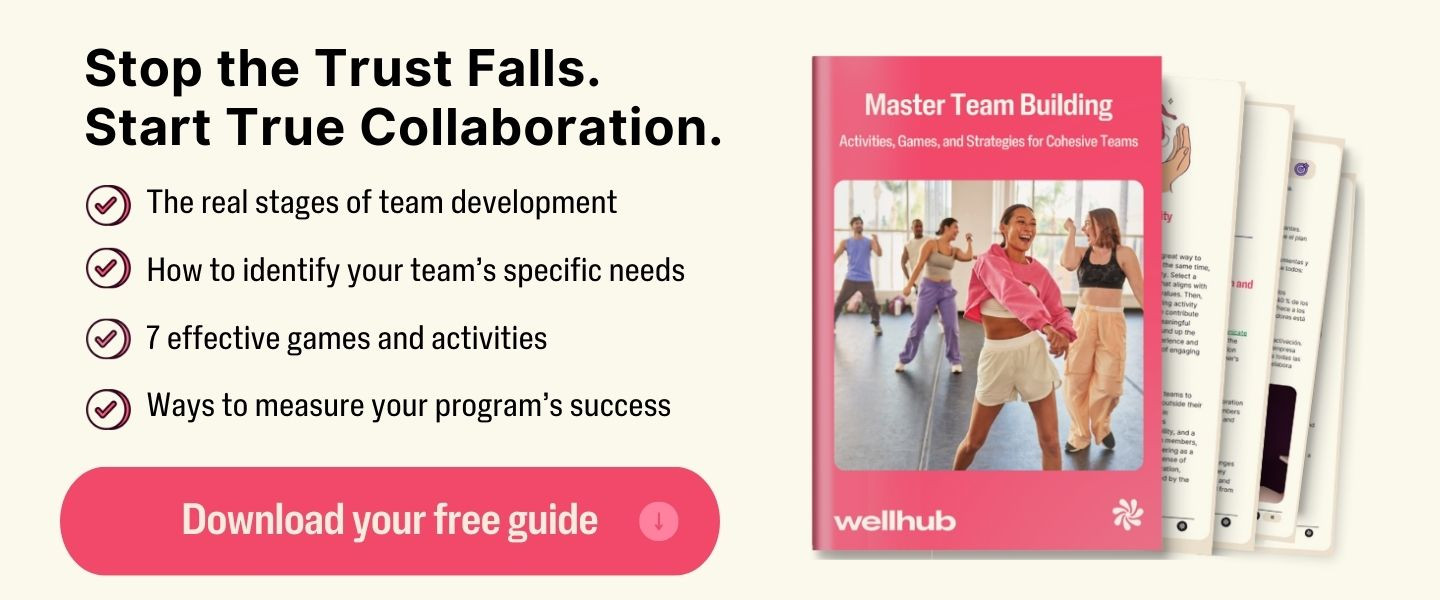
What You'll Learn
- Why employee retention programs matter—and how they save costs, boost morale, and strengthen culture.
- The key components of successful programs, from competitive pay and benefits to wellness, recognition, and leadership development.
- Practical strategies to reduce turnover, including mentorship, flexibility, and actionable employee feedback.
- The business benefits of retention, such as improved productivity, customer experience, and competitive advantage.
- How to measure success using employee retention KPIs like turnover rate, internal mobility, and engagement scores.
What Is an Employee Retention Program?
An employee retention program is a strategic, proactive plan that organizations use to keep their top talent. It keeps employees engaged, growing, and satisfied.
What Do Employee Retention Programs Include?
| Program Component | What It Achieves |
|---|---|
| Competitive Compensation & Benefits | Shows employees they’re valued financially and holistically |
| Career Development Programs | Offers growth and promotion opportunities |
| Recognition Systems | Celebrates wins and reinforces purpose |
| Wellness Programs | Supports physical, mental, and emotional wellbeing |
| Flexible Work Options | Encourages autonomy and life balance |
| Leadership Development | Builds better managers—one of the top predictors of retention |
The Goal of a Retention Program:
Employee retention programs aim to reduce voluntary turnover by making your organization a place where people want to stay—because they feel:
- Valued
- Supported
- Challenged
- Connected
- Well-compensated
What Makes a Retention Program Effective?
An effective program gets ahead of turnover. Instead of responding to employees leaving, it stops them from turning in their 2 week notice in the first place. The best retention programs:
- Identify why employees leave through exit data, pulse surveys, and stay interviews.
- Address those pain points through thoughtful investments in pay, culture, growth, and flexibility.
- Create career pathways that help employees visualize a long-term future with the company.
- Support wellbeing and work-life balance, recognizing the link between health and longevity.
- Build a culture of recognition and belonging, so people feel appreciated and connected.
Benefits of Retention Programs
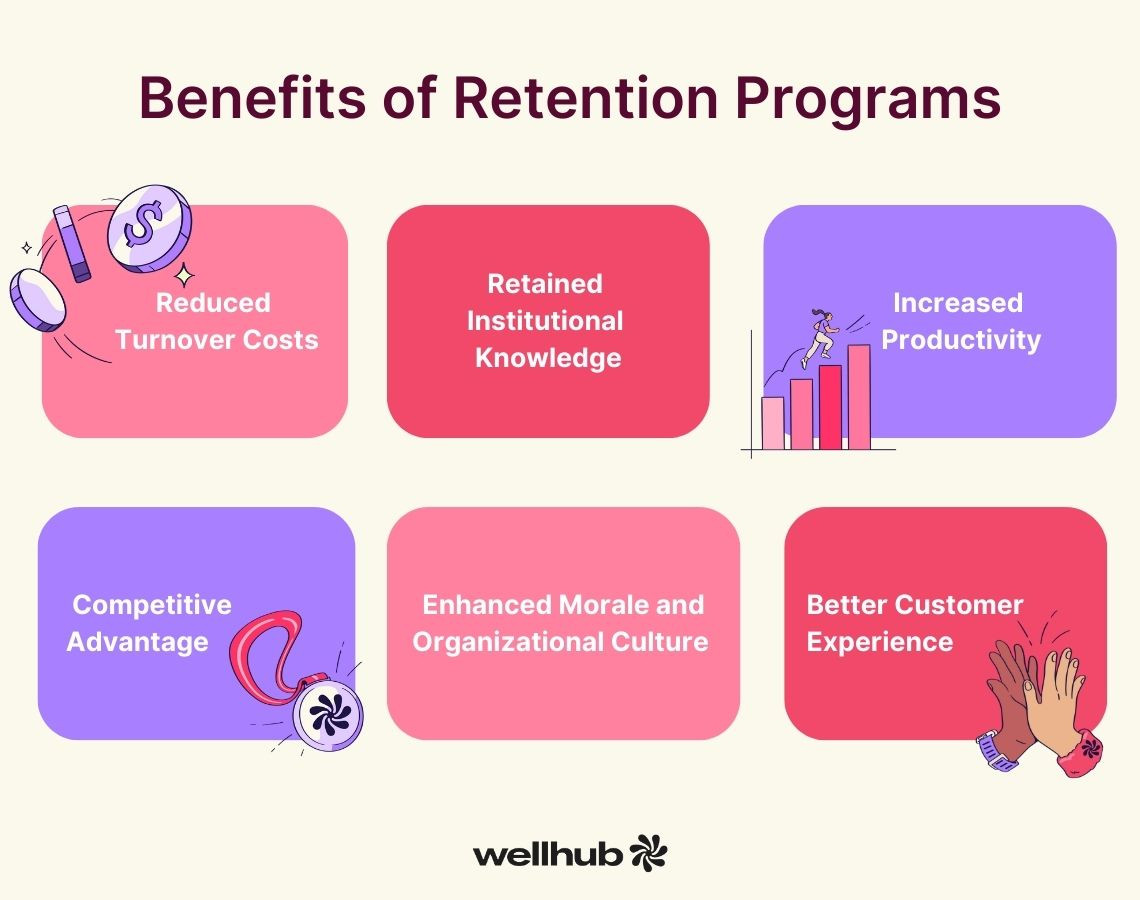
Strong retention programs provide many benefits for companies, including:
- Reduced costs: High turnover can be costly. Lower turnover saves money on recruitment, onboarding, and training.
- Increased productivity: Long-term employees usually have a deeper understanding of their roles and organizational operations, making them more productive and effective in their roles.
- Enhanced morale and organizational culture: When employees stay for long periods of time, team composition remains stable. This allows for stronger team relationships to form, improving collaboration. On the other hand, constant turnover can disrupt team dynamics and push heavy workloads on to remaining employees.
- Improved customer experience: Experienced employees who are happy and knowledgeable are more likely to deliver better service. This, in turn, boosts customer satisfaction and loyalty.
- Retained institutional knowledge: Long-tenured staff preserve insights and knowledge that may otherwise leave with departing workers.
- Competitive advantage: Companies with strong retention—those that do not repeatedly advertise for the same positions—appear as stable and desirable workplaces. They’re more likely to attract and retain top candidates looking for a long-term place to grow.
10 Examples of Employee Retention Programs
A successful employee retention program must address all potential issues that could cause people to leave, whether that’s a lack of competitive employee benefits or a toxic work culture. Here’s what you should consider when building the best retention program for your organization.
- Competitive Compensation and Benefits
Everyone wants to be paid at or above the industry standard. Unsurprisingly, in 2024, 21% of employees chose to leave a job due to unsatisfactory pay, according to iHire.
To retain and attract employees, you need to offer competitive compensation. This means regularly benchmarking salaries against market rates and ensuring employees feel fairly rewarded for their contributions.
You also need to offer competitive benefits. Leading organizations typically provide:
- Comprehensive health coverage, including medical, dental, and vision insurance.
- Paid time off, holidays, and flexible leave options.
- Flexible work options, such as hybrid and remote work, if relevant or possible for the position.
- Retirement plans with employer contributions.
- Lifestyle benefits such as commuter stipends or student loan repayment assistance
A holistic approach to compensation shows that the company is invested in the person as a whole.
- Opportunities for Career Development and Growth
Employees want to see a future at their company, especially young people. Without a clear path forward, people are more likely to leave for growth elsewhere.
In fact, 83% of Gen Z U.S. workers consider themselves job hoppers, according to ResumeLab. Unlike their older peers, they believe rapid job-switching doesn't show a lack of commitment but a desire for new environments and challenges that match their goals and values.
To attract and retain these ambitious, growth-oriented workers, HR leaders and executives can try the following retention strategies:
- Mentorship programs that pair junior employees with experienced colleagues.
- Tuition reimbursement or funding for certifications.
- Structured career ladders with transparent criteria for promotions.
- Access to online learning platforms and mindful leadership training
By showing employees that climbing the career ladder is possible, organizations inspire loyalty and long-term commitment.

- Effective Recognition and Rewards
It’s human nature for people to want to know their work matters. When we feel valued, we’re more likely to remain engaged and loyal.
That’s why recognition is one of the most powerful drivers of retention. More than half of employees consider meaningful recognition a key factor in staying with their employer, as iHire reports.
Recognition can be monetary or non-monetary and should be consistent, timely, and authentic. Here are some examples of employee appreciation ideas:
- Bonuses for exceptional performance.
- Structured systems for giving and receiving feedback, such as peer-to-peer recognition platforms.
- Ways to recognize employees, such as public shout-outs during team meetings.
- Annual awards programs tied to company values.
Over the long term, recognition reinforces desired behaviors and fosters a culture of appreciation. This, in turn, minimizes frustration and boosts job satisfaction, which can lead to higher retention rates.
- A Positive and Supportive Workplace Culture
In 2024, the top reason workers left was a negative or toxic work environment, cited by 32% of workers. Poor organizational leadership (30%) and unhappiness with one’s supervisor or manager (28%) closely followed, according to iHire. To counter the negative effects of a toxic work culture, organizations need to intentionally build a positive culture where employees feel supported. Effective strategies include:
- Hosting regular team-building activities.
- Encouraging open communication and transparency from leadership.
- Prioritizing workplace safety and avoiding workplace harassment.
- Aligning business values with employee values, especially around diversity and inclusion
When people feel supported and respected for their contributions and valued as individuals, they are far more likely to remain with the organization.
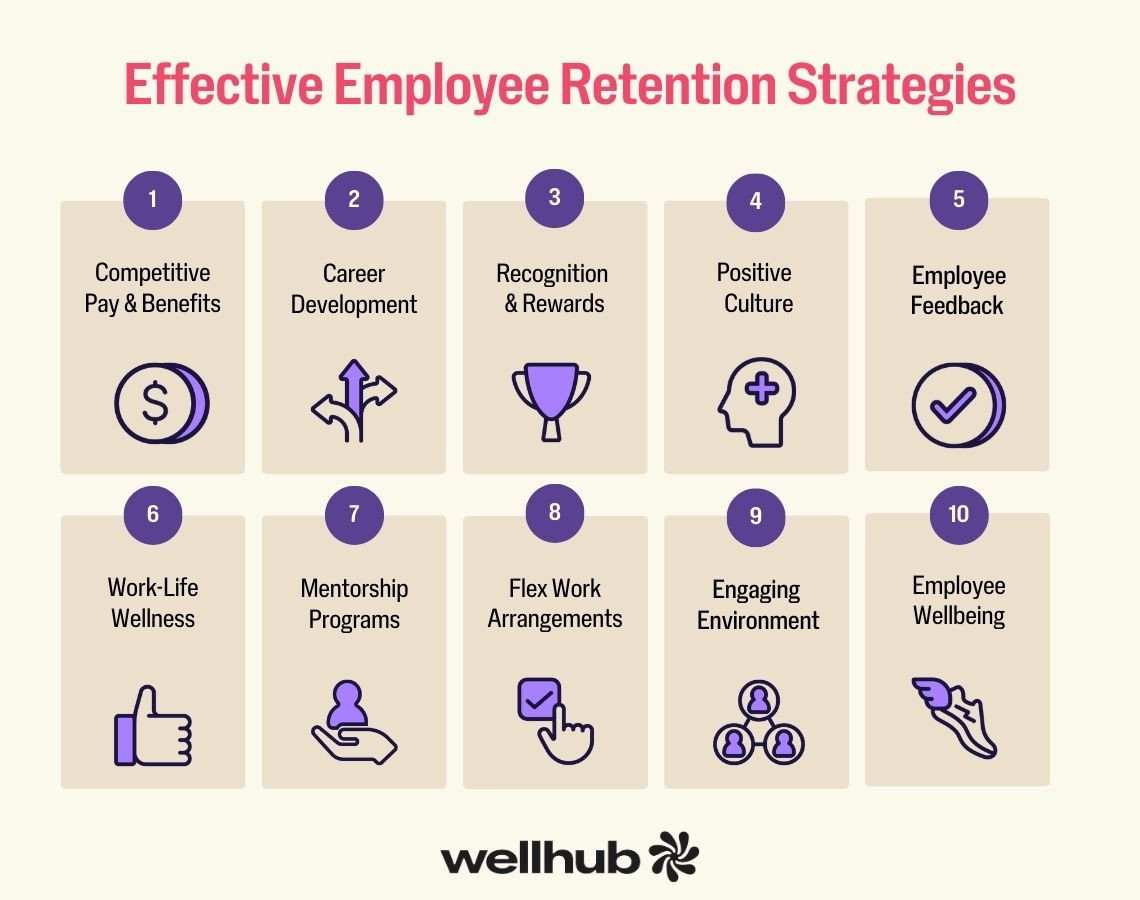
- Insights from Employee Feedback
When employees feel heard, they’re less likely to leave. However, many organizations aren’t proactively using feedback. Only 17.2% of employers have conducted stay interviews in the past year, according to iHire, leaving a significant gap in employee feedback about what motivates them to stay.
Without these insights, leaders miss the chance to address issues before they lead to resignations. Effective ways to get employee feedback include:
- Pulse surveys to measure engagement in real time.
- “Stay interviews” to learn what motivates employees to remain.
- Exit interviews to understand why people leave.
Remember to always act on feedback. Employees will lose trust in the company if leaders collect but ultimately fail to act on their insights.
- Work-Life Wellness
Supporting employees during work is only the first step. Around 68% of employees highly value companies committed to promoting healthy work-life wellness, per iHire. Investing in work-life wellness programs enables people to balance their careers and personal lives. This research also shows that organizations can build this balance by implementing policies such as:
- Flexible scheduling to accommodate childcare or education: Over half of employees said they are more likely to stay at a workplace if employers offer flex time.
- Allowing people to work hybrid or remote when needed: Over 40% of employees say they’re more likely to stay at a company if it offers hybrid or remote work options.
- Encouraging employees to take full advantage of PTO without guilt: Over 40% of employees say they’re more likely to remain at an organization that provides unlimited PTO.
- Providing access to resources that prevent burnout, such as stress-management workshops and wellbeing apps.
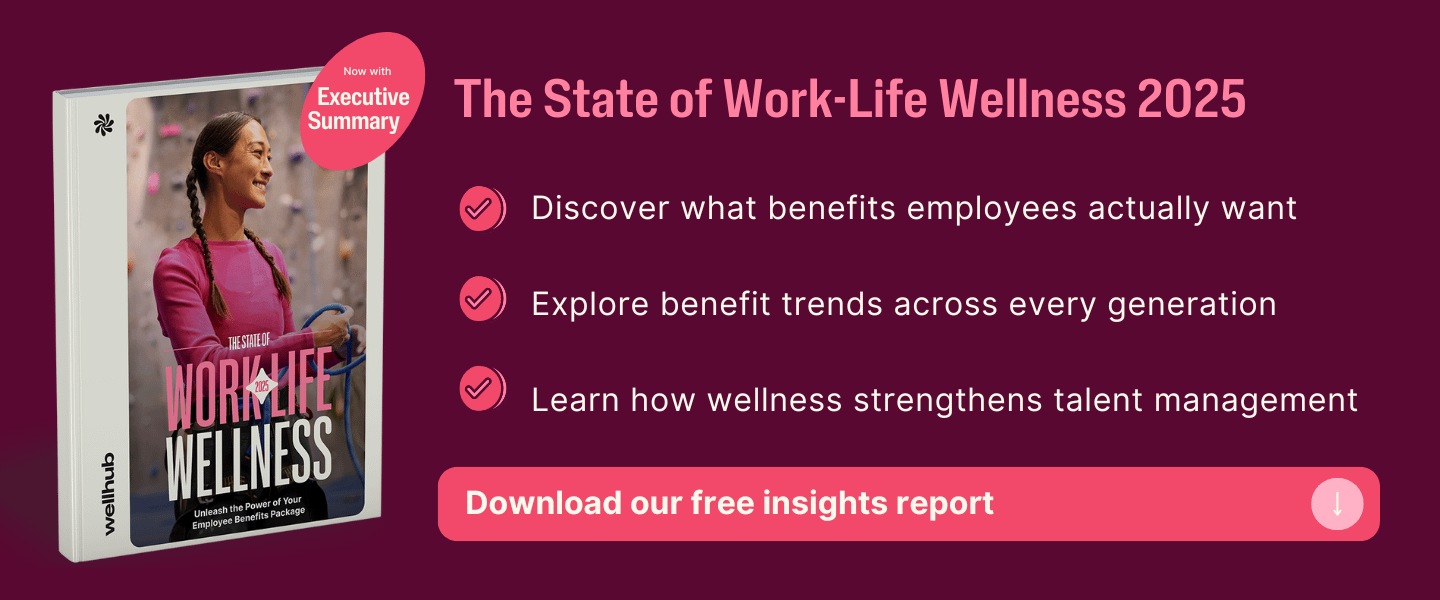
- Mentorship Programs
Professional growth remains one of the strongest drivers of retention.
Over 60% of employees want access to professional development opportunities, 56% want clear paths to promotion or advancement, and 47% appreciate cross-training opportunities to learn skills outside their typical department or role, per iHire.
Implementing a structured mentorship program is one of the best ways to meet these expectations. Whether offered internally or through external partners, mentorship gives employees a dedicated resource for support and guidance. Over time, it builds trust, accelerates learning, and creates meaningful cross-generational connections.
Elements of effective mentorship programs include clear objectives, regular check-ins, and recognition for both mentors and mentees.
- Flexible Work Arrangements
Flexibility is now a baseline expectation. For 76% of workers, having the choice of when and where to work affects their desire to stay with a company, according to Robert Half.
Flexible arrangements allow employees to manage their productivity, reduce commuting stress, retain higher energy levels, boost employee satisfaction, and prevent burnout. Common approaches include:
- Hybrid schedules that combine office and remote days
- Compressed workweeks or seasonal summer hours
- Job-sharing models for specific roles
When organizations provide flexibility, they give employees more autonomy. This enhances trust, leading to loyalty and higher retention rates.
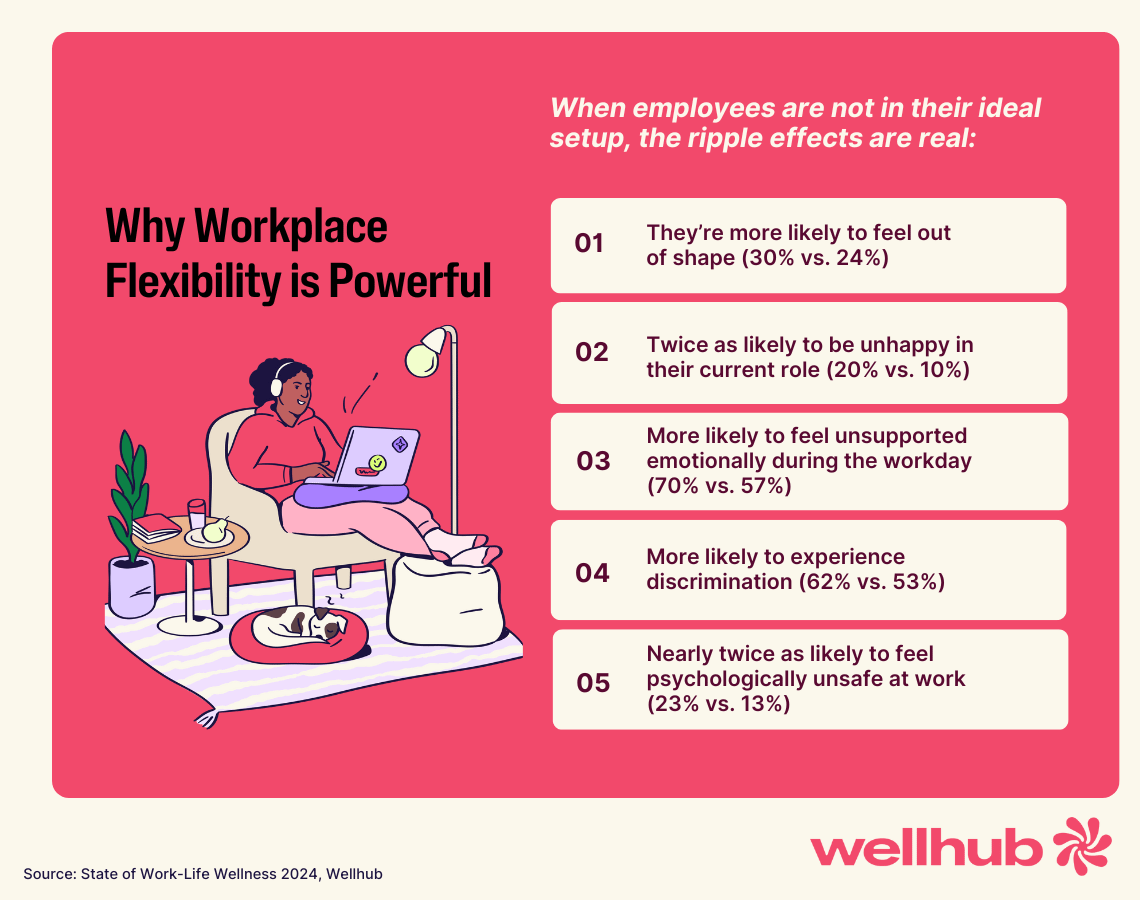
- Communicative and Collaborative Environment
Employees are far more likely to stay when they feel genuinely connected to their colleagues and leaders.
Still, many organizations struggle to keep those connections strong. An alarming 37% of employees get their information about their organization from external sources like social media and the internet, per the Employee Communication Impact Study 2024. This is a clear sign that internal communication is falling short.
Fortunately, there’s a solution: creating a communicative and collaborative environment that fosters belonging and reduces the isolation driving disengagement. Here’s how to create such an environment:
- Regular one-on-one check-ins between managers and direct reports
- Clear communication channels for cross-functional projects and feedback
- Transparent sharing of company goals and KPIs
- Investing in Employee Wellbeing
Wellness offerings—including resources for mental, physical, and financial wellbeing—have become the industry standard. An impressive 62% of organizations provide access to wellness programs to improve overall worker health and wellbeing, per the Workplace Wellness and Financial Education: 2025 Survey Report.
Wellness initiatives show that you care about your employees beyond the office. They also help reduce the risk of burnout, a leading driver of turnover. You can offer wellness as a perk with programs such as: on-demand fitness classes, nutrition and sleep apps, financial wellness tools, and emotional health resources like mindfulness and meditation.
How to Build an Employee Retention Program (Step by Step)
Creating a successful employee retention program isn’t just about preventing turnover—it’s about designing a workplace people want to stay in. This actionable guide walks you through building a strategic and effective retention program.
Step 1: Define Long-Term Retention Goals
Start by asking yourself: What does “retention success” look like for your organization?
Set clear, measurable, and time-bound goals. For example: “Reduce turnover by 15% within 12 months” or “Increase internal promotions by 25% over two years.” These goals should align with your broader business strategy—whether that’s scaling fast, stabilizing after growth, or deepening institutional knowledge. This clarity ensures every element of your program ladders up to something bigger than just plugging holes.
Step 2: Audit Current Retention Gaps
Before you build something new, evaluate what’s working—and what isn’t.
Use exit interviews, employee satisfaction surveys, stay interviews, and performance trends to uncover why people leave and what keeps them around. Are people exiting for higher pay? Burnout? Poor management? Or because they don’t see a path forward? Understanding these reasons helps you prioritize your solutions and avoid assumptions.
Pro tip: Only 17.2% of employers conducted stay interviews last year, per iHire. That’s a missed opportunity—don’t let it be one for you.
Step 3: Identify Your Retention Levers
Not all turnover drivers are equal. Focus your program on the top issues revealed in your audit.
Common areas to address include:
- Competitive pay and benefits
- Career development opportunities
- Recognition and rewards
- Manager training and leadership
- Flexibility and work-life wellness
Prioritize the ones that most impact your team. For instance, if Gen Z employees are rapidly churning, you may need to invest in growth opportunities and mentorship. If stress and burnout are top complaints, it’s time to think wellness, flexibility, and PTO culture.
Step 4: Align Budget With Impact
Retention efforts come with a cost—but turnover costs more. Replacing an employee can cost up to twice their salary.
Start by estimating the ROI of solving your top pain points. For example, mentorship programs may require time and coordination, but they directly reduce voluntary turnover and improve internal mobility. Wellness programs may carry upfront costs but lead to lower absenteeism and healthcare spend—67% of CEOs report wellness programs reduce absenteeism.
Design your budget around what your team needs most—then use that to get C-suite buy-in.
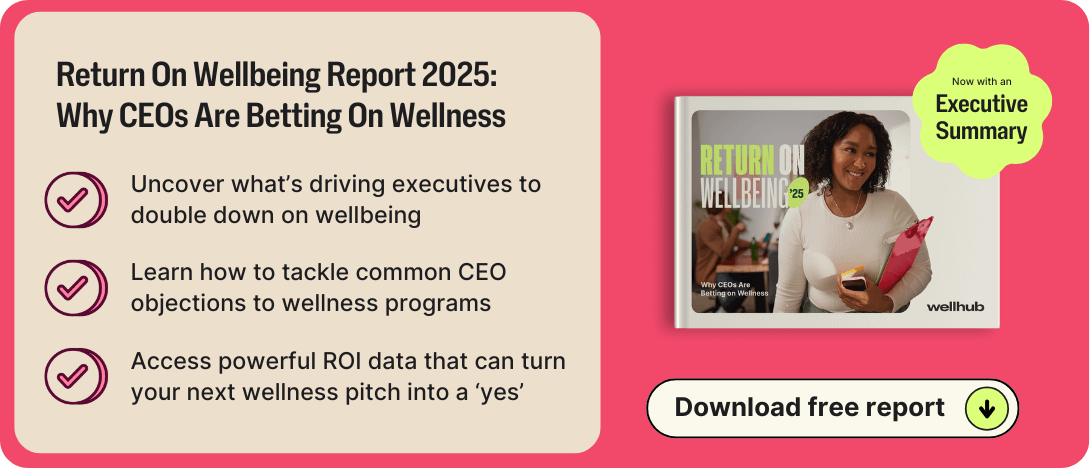
Step 5: Build Your Core Program Components
Now it’s time to build. Your retention program should feel intentional and people-first. The best programs often include:
- Compensation benchmarking (pay and benefits)
- Structured career paths and L&D access
- Recognition systems that include peer-to-peer and manager-led recognition
- Flexible scheduling or remote/hybrid options
- Wellness support, from mental health tools to fitness benefits
- Manager enablement to improve communication and coaching
Remember, you don’t need to launch everything at once. Start with the areas of highest impact, and build from there.
Step 6: Communicate the Program with Clarity and Excitement
A great retention program doesn’t work if no one knows it exists.
Develop a thoughtful rollout strategy with emails, manager toolkits, FAQ sessions, and leadership messaging that outlines the why behind the program. Emphasize how these initiatives are tied to what employees have said they value.
Transparency builds trust. Trust drives retention.
Step 7: Train Your Managers—They’re the Linchpin
You can design a perfect program, but if your managers aren’t bought in, it will never land.
Equip people leaders with the tools to reinforce retention strategies. Offer training on coaching, feedback, recognition, and wellbeing support. After all, unhappiness with one’s manager was the #3 reason people left jobs in 2024 .
Strong, supportive managers are the glue that holds retention programs together.
Step 8: Gather Feedback and Adapt
Your retention strategy should never be static.
Run quarterly pulse surveys and annual stay interviews. Create feedback loops that allow employees to tell you what’s working and what’s missing. Then act on that information. When employees see real change come from their input, loyalty goes up.
Adaptation isn’t a sign of failure—it’s a hallmark of strategic HR leadership.
Step 9: Track Metrics That Matter
Retention success needs to be measurable.
Track metrics such as:
- Turnover rate by department, tenure, and level
- Promotion rates
- Internal mobility
- Employee Net Promoter Score (eNPS)
- Program utilization rates (e.g., mentorship participation, wellness engagement)
Combine this data with qualitative insights to form a complete picture—and use it to continuously iterate.
Step 10: Integrate Retention Into Company Culture
The most effective retention programs aren’t “programs” at all—they become part of how your company works.
From onboarding to leadership training to quarterly all-hands, make retention a recurring theme. Reinforce your commitment to career growth, work-life wellness, and employee value. Over time, your program becomes part of your brand—and your competitive advantage.
How to Measure Program Success: Employee Retention KPIs
Employee retention KPIs (key performance indicators) are measurable metrics that help you track how well your organization is keeping talent over time. These KPIs go beyond just turnover rates—they paint a full picture of how your workforce is growing, staying, or leaving.
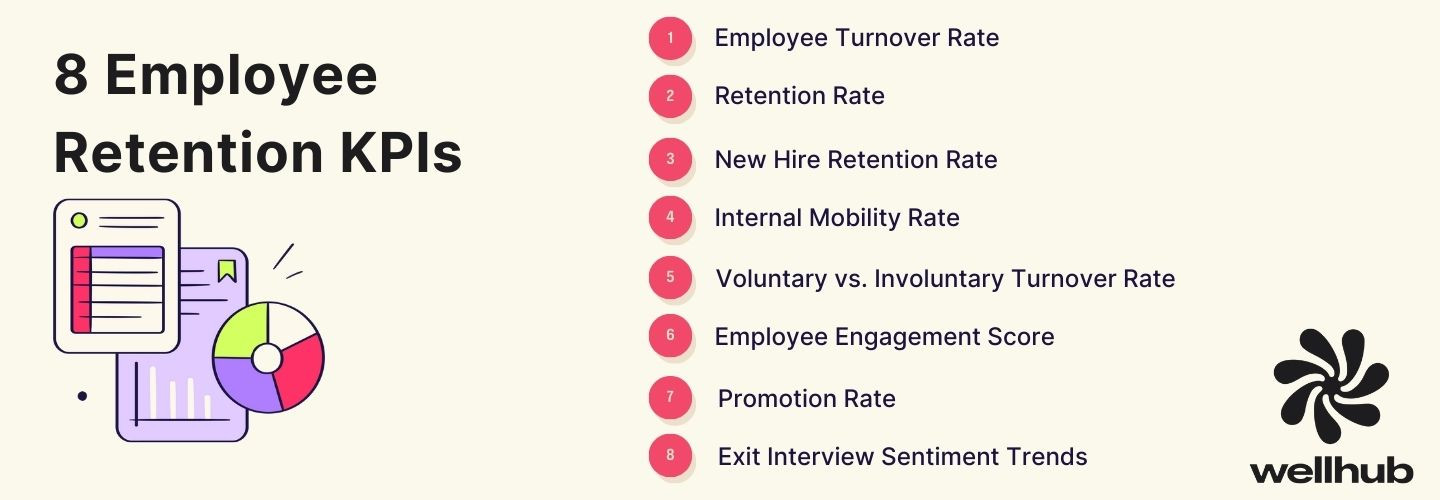
- Employee Turnover Rate
What it is: Turnover rate is the percentage of employees who leave your organization during a given period, typically calculated monthly, quarterly, or annually.
Where to find the data: Your HRIS or payroll system should provide employee start and end dates. You’ll also need headcount figures at the beginning and end of the tracking period.
How to track it: Track it monthly to spot trends—are departures seasonal or steady? Segment by department, role, or manager to identify hotspots. You can also compare voluntary vs. involuntary turnover to get more context.
Formula: (Number of separations ÷ Average number of employees) x 100
- Retention Rate
What it is: Retention rate measures the percentage of employees who stay with your company over a given period. It’s the positive flip side of turnover.
Where to find the data: Also in your HRIS, by pulling the number of employees who were present at the start of a period and are still employed at the end.
How to track it: Track retention quarterly and annually. You can also assess it for specific cohorts—for example, new hires who joined in Q1 and were still employed after 12 months.
Formula: (Number of employees who stayed ÷ Total number at the start of period) x 100
- New Hire Retention Rate
What it is: This measures how many new hires remain with the company after a certain period (often 30, 60, or 90 days, or one year).
Where to find the data: Use onboarding records and exit data in your applicant tracking system (ATS) and HRIS.
How to track it: Create a cohort analysis for each hiring class. If you hired 20 people in March, how many are still here in June? Track over 12 months to evaluate onboarding effectiveness and cultural alignment.
- Internal Mobility Rate
What it is: This shows how often employees move into new roles within your organization—either lateral or promotional. It’s a great indicator of growth opportunities and internal career development.
Where to find the data: Your HRIS or talent management platform should track job changes and promotions.
How to track it: Set quarterly and annual benchmarks. You can calculate mobility by department or tenure to identify where opportunities are (or aren’t) happening.
Formula: (Number of internal moves ÷ Average headcount) x 100
- Voluntary vs. Involuntary Turnover Rate
What it is: This breaks your total turnover into two types:
- Voluntary = employees who choose to leave
- Involuntary = employees who are terminated
Where to find the data: Exit interview logs, separation records, and termination codes in your HRIS.
How to track it: Track over time to identify patterns. A high voluntary turnover rate is a red flag for culture, pay, or development issues. A high involuntary rate may signal poor hiring practices or performance issues.
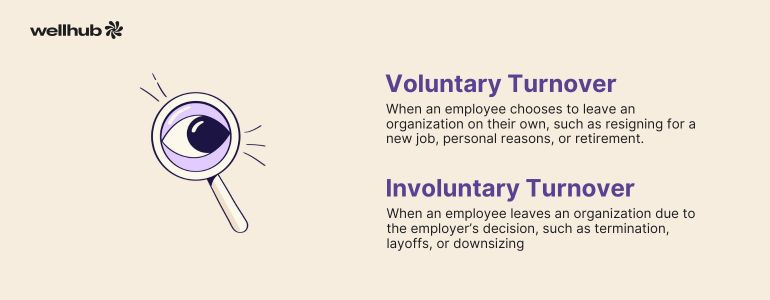
- Employee Engagement Score
What it is: This KPI uses survey data to measure how connected, motivated, and committed employees feel at work. Higher engagement usually equals higher retention.
Where to find the data: Pulse surveys, annual engagement surveys, or platforms like Culture Amp, Glint, or Officevibe.
How to track it: Benchmark engagement by department, tenure, or job function. Look for declines over time or after major org changes. Pair with retention data to draw deeper conclusions.
- Promotion Rate
What it is: The percentage of employees who have been promoted over a specific time frame. A high promotion rate can signal strong career pathways.
Where to find the data: Track job level changes and promotions in your HRIS or performance management software.
How to track it: Track by department and demographic to ensure equity. Annual tracking works well here—too frequent and you won’t see much movement.
Formula: (Number of promotions ÷ Total employees) x 100
- Exit Interview Sentiment Trends
What it is: Not a number—but a qualitative KPI. This identifies the top themes and reasons employees cite for leaving. Over time, it helps you detect patterns you can act on.
Where to find the data: Exit interview forms, surveys, or conversations—ideally tagged and stored in a centralized system like your HRIS, Notion, or Qualtrics.
How to track it: Manually or automatically code feedback into categories like “compensation,” “culture,” “career growth,” etc. Visualize these trends quarterly to align retention efforts with real concerns.
Bonus KPI: Wellness Program Utilization Rate
Why it matters: Wellness and retention are deeply connected. Companies that offer wellness programs report 61% employee happiness vs. 36% without, and 73% of CEOs say wellness programs directly improve retention.
How to track it: Use data from your wellness vendors (like Wellhub!) to track engagement, logins, and active usage. Pair this with retention data for a powerful narrativea bout how your investment in wellbeing is paying off.
Final Tip: Bring It All Together With a Dashboard
To track these KPIs over time:
- Use your HRIS for core data
- Connect with Excel, Power BI, or Tableau for visualization
- Set quarterly check-ins to analyze trends
- Pair quantitative data (turnover rate) with qualitative insights (exit interviews) for a full picture
Would you like a plug-and-play KPI dashboard template or example format next?
Prioritizing Wellbeing Drives Retention That Lasts
Retention efforts fall short when they focus only on pay. Burnout, disengagement, and lack of support push employees out the door—even when salaries are competitive: 88% of employees value their wellbeing at work just as much as their salary.
A strong wellbeing program tackles those issues head-on. It boosts energy, morale, and team connection while lowering stress and turnover risk.
Speak with a Wellhub wellbeing specialist to build a workplace that supports your people and keeps them around.

Company healthcare costs drop by up to 35% with Wellhub*
See how we can help you reduce your healthcare spending.
[*] Based on proprietary research comparing healthcare costs of active Wellhub users to non-users.
Category
Share

The Wellhub Editorial Team empowers HR leaders to support worker wellbeing. Our original research, trend analyses, and helpful how-tos provide the tools they need to improve workforce wellness in today's fast-shifting professional landscape.
Subscribe
Our weekly newsletter is your source of education and inspiration to help you create a corporate wellness program that actually matters.
Subscribe
Our weekly newsletter is your source of education and inspiration to help you create a corporate wellness program that actually matters.
You May Also Like

Talent Management: Definition, Benefits, and Strategies | Wellhub
Discover talent management best practices to attract, retain, and develop top talent. Leverage these benefits and strategie to align with your business goals.

Employment At Will: What It Means for Employers | Wellhub
At-will employment offers termination flexibility for employers and employees. Explore strategies to mitigate risks and ensure fair practices in the workplace.

6 Essential Team Lead Responsibilities | Wellhub
Team leads take on many responsibilities to help their team be successful. Discover which responsibilities are the most critical for success.